|
|
|
|
Cleromancy
An Addendum
by Hebeloma Crustuliniforme
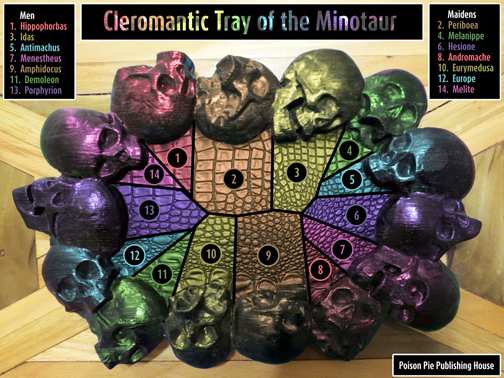
In March 2018, the staff of the Poison Pie Publishing House published an An Introductory Guide to Cleromancy, focusing on the tools of the trade. In this addendum to that document, we provide sporadic updates to the tools.
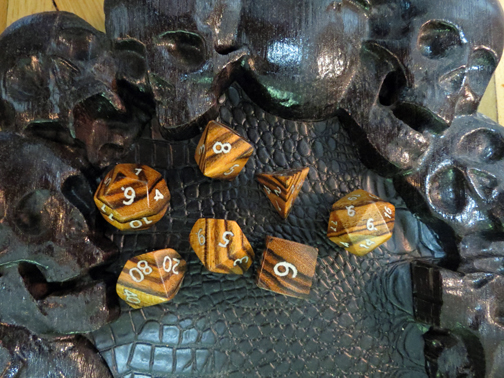
These stones are cut from bocote, the wood of (Cordia alliodora), a flowering tree native to the American tropics. They were crafted by the artisans of Dog Might Games of Ann Arbor, Michigan. The engraved numbers are inlaid with crushed nacre, or mother-of-pearl. Nacre is a composite material produced by some molluscs as an inner shell layer. Nacre is composed of stacks of layers of aragonite (a form of calcium carbonate), separated by sheets of elastic biopolymers (such as chitin). This combination of wood and mineral, organic and inorganic, harvested from plant and animal sources, makes these stones particularly suited for divination on the subjects of agriculture and animal husbandry.
May 12, 2018
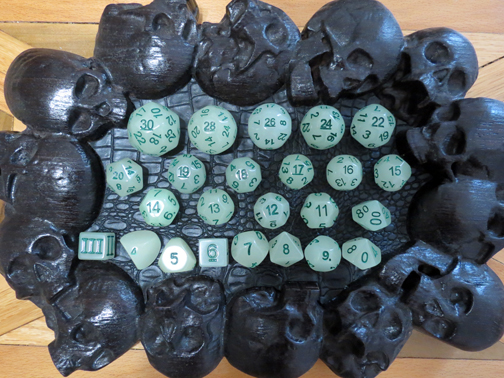
This set of twenty-four stones is designed to generate random integers up to 3, 4, 5, 6, 7, 8, 9, 10, 11, 12, 13, 14, 15, 16, 17, 18, 19, 20, 22, 24, 26, 28 and 30. A second ten-sided die is included to generate a number in the tens digit between 10 and 100. Taken with the ten-sided die with single digits, they generate a number between 1 and 100. While the dice were advertised as "chi-squared tested for rolling equal probabilities", an examination of the odd-shaped dice shows obvious and significant asymmetry. It seems likely that the odd-shaped die can generate random integers along some probability distribution other than the uniform distribution.
Certain selections of odd-shaped die are ideal for cleromancy on the equally odd topics of culinary adventures, insanity of various sorts and puberty.
These particular dice are manufactured from a polymer with a glow-in-the-dark dye. These dice were manufactured by Impact Miniatures of Indianapolis, Indiana.
May 14 & 19, 2018
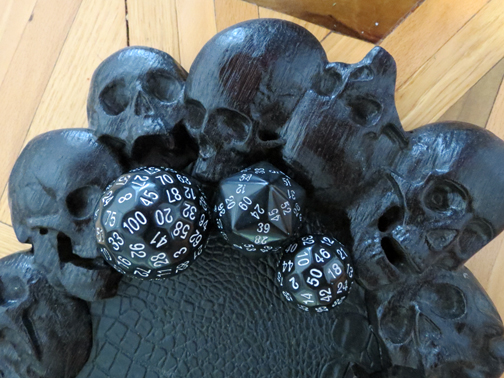
There are also stones that have been crafted to generate a uniform distribution of larger integers. In the example above, three polymeric dice are shown, which have one hundred, sixty and fifty sides. Such dice are ideal for cleromancy on the numerological subjects of longevity, speculative wagers, vacations and eclipses.
These polymeric dice were manufactured by Bescon Industrial Company, Limited of Ningbo, Zhejiang, China.
May 19, 2018
These polymeric dice were originally an exclusive of the inaugural HASCON convention of September 8-10, 2017 in Providence, Rhode Island. They are intended to appeal to young girls interested in cleromancy, by linking the stones to the main characters of the My Little Pony® franchise. The set included the standard set of seven polyhedra and three additional cubic dice, packaged in a metal tin and secured with a foam interior. The lid of the metal tin features from left to right the following pony luminaries: Pinkie Pie (barbarian), Rarity (cleric), Twilight Sparkle (wizard), Fluttershy (druid), Applejack (ranger) and Rainbow Dash (rogue). The paper sleeve, which slides over the closed tin, features Rainbow Dash and Pinkie Pie.
According to girls in the know, these dice are ideal for cleromancy on topics of laughter, friendship, magic and of course sundry equestrian events.
These particular die are manufactured from a polymeric material. These dice were manufactured by Hasbro Incorporated of Pawtucket, Rhode Island.
May 19, 2018
| | |
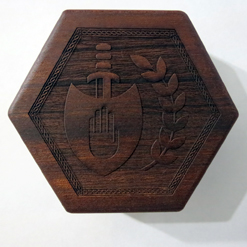 |
|
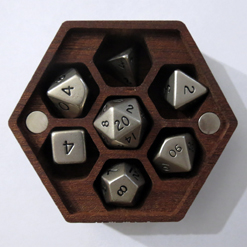 |
| | |
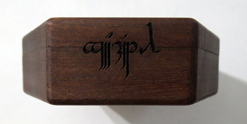 |
|
As noted in the main document, some cleromancers attempt to influence the entities to which they direct their queries by storing the stones in containers thought to appeal to the esthetic sensibilities of the entity. In this example a mahogany (Swietenia macrophylla) box cut in the shape of a hexagon contains in the interior seven hexagonal niches, intended to hold the traditional set of seven dice. This box is held closed by magnets. On the surface it is inscribed with a sword, a shield bearing one open hand, and an olive branch. Presumably, this symbolism conveys peace through military force or, perhaps, more optimistically, peace strengthened by an underlying resolve. Along one facet of the hexagon on the side of the box, the name of the cleromancer is inscribed in Tengwar script of J.R.R. Tolkien.
This box was crafted by Elderwood Academy of Ann Arbor, Michigan.
The stones are smooth stainless steel of uncertain origin. Given their container and the choice of unyielding material, consistent with the sword and shield motif, one assumes that such stones are intended to be used for prediction of wartime endeavors and the outcome of related peace treaties.
June 9, 2018
| | |
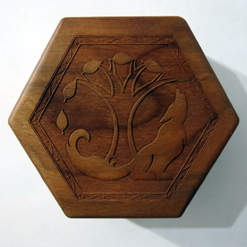 |
|
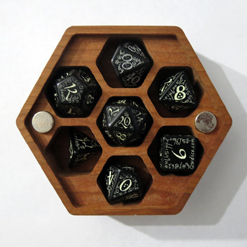 |
| | |
|
| 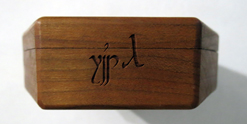 |
This hexagonal box is made from cherry (Prunus serotina). On the surface it is inscribed with a howling wolf and a tree whose leaves have been blown by a passing wind into a circle, and not by happenstance. Again, along one facet of the hexagon on the side of the box, the name of the cleromancer is inscribed in Tengwar script of J.R.R. Tolkien.
This box was crafted by Elderwood Academy of Ann Arbor, Michigan.
The polymer stones shown are from the Q-Workshop of Poznań, Poland. They are also marked with an Elvish script. A set of the standard seven polyhedra dice, cast in black polymer with glow-in-the-dark ink, was acquired, but a manufacturing defect (a lump of polymer on one of the faces) was found on the d00 die. Q-Workshop was contacted and they sent the closest replacement they could find, in which the Elvish script is duplicated but the ink is replaced with silver. So it is that the stones of cleromancers possess their own imperfections. In any case, the stones kept in this box are intended to be used for prediction of ecological matters of all sorts, including the fates of ecosystems, the particular dates of seasonal transitions, and the survival of species of flora and fauna.
June 10, 2018
| | |
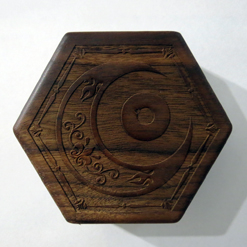 |
|
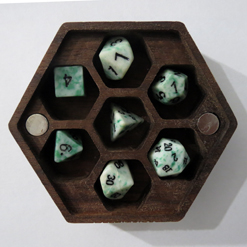 |
| | |
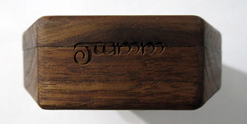 |
|
This hexagonal box is made of walnut (Juglans nigra) and includes an interior with seven hexagonal niches, intended to hold the traditional set of seven dice. The nature of the script and the manufacture are the same as for the hexagonal boxes described above. The surface of this box is inscribed with a stylized crescent moon, inside of which is a round stone with a hole in it. The symbolism of the rounded stone pierced by a hole is given in Aradia, The Gospel of the Witches, edited by Charles G. Leland, London, David Nutt, 1899. In Chapter IV: The Charm of the Stones Consecrated to Diana (pp. 23-25), one finds the following passage.
To find a stone with a hole in it is a special sign of the favour of Diana. He who does so shall take it in his hand and repeat the following, having observed the ceremony as enjoined:--
Invocation to the Holy-Stone.
I have found
A holy-stone upon the ground.
O Fate! I thank thee for the happy find,
Also the spirit who upon this road
Hath given it to me;
And may it prove to be for my true good
And my good fortune!
I rise in the morning by the earliest dawn,
And I go forth to walk through (pleasant) vales,
All in the mountains or the meadows fair,
Seeking for luck while onward still I roam,
Seeking for rue and vervain scented sweet,
Because they bring good fortune unto all.
I keep them safely guarded in my bosom,
That none may know it--'tis a secret thing,
And sacred too, and thus I speak the spell:
"O vervain! ever be a benefit,
And may thy blessing be upon the witch
Or on the fairy who did give thee to me!"
It was Diana who did come to me,
All in the night in a dream, and said to me:
"If thou would'st keep all evil folk afar,
Then ever keep the vervain and the rue
Safely beside thee!"
Great Diana! thou
Who art the queen of heaven and of earth,
And of the infernal lands--yea, thou who art
Protectress of all men unfortunate,
Of thieves and murderers, and of women too
Who lead an evil life, and yet hast known
That their nature was not evil, thou, Diana,
Hast still conferred on them some joy in life.
Or I may truly at another time
So conjure thee that thou shalt have no peace
Or happiness, for thou shalt ever be
In suffering until thou grantest that
Which I require in strictest faith from thee!
When kept in a container such as this, the jade stones are intended for cleromancy on all subjects related to the moon and to witchcraft, both black and white.
June 16, 2018
This set of seven metallic die feature a geometric, reticulated pattern and stylized edges that swell around specific points, as if they were welds at the junctures of structural elements. The numbers on each die are presented in a gothic font with the highest number being replaced by a script capital letter "P".
These metallic dice were manufactured by the Q-Workshop of Poznań, Poland for the Pathfinder Roleplaying Game, a property of Paizo Publishing of Redmond, Washington. The dice were distributed in a cardboard box with a foam interior intended to hold the seven dice in place. With regard to cleromancy, these dice can be used as casting stones in the divination of matters related to the stability of edifices, with or without metal structural reinforcement, the finding of individuals lost along wilderness paths and other sundry topics related to the letter "p" or the number 16.
June 29, 2018
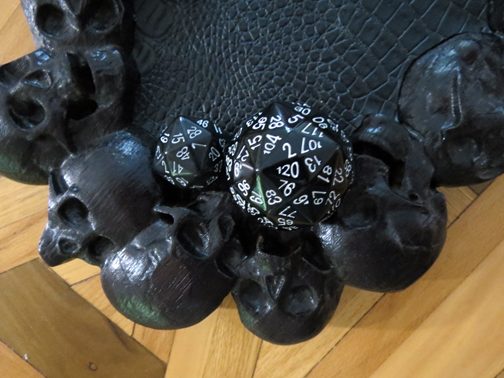
Stones exist the shape of a polyhedron possessing up to 120 sides. It is said that the disdyakis triacontahedron (120-sided polyhedron) possesses the most faces, for which each face is identical to all others. Here it is accompanied by a 48-sided stone, disdyakis dodecahedron.
In cleromancy, such dice are used to predict outcomes relating to irrational phobias, recurring rejection and the occult subject of impossible arithmetic.
These polymeric dice were manufactured by The Dice Lab of Phoenix, Arizona.
August 19, 2018
As noted in the original article, many tools of cleromancy have found their way into ornate storage cases. This box is intended to hold six sets of polyhedral dice. The symbol engraved on the top of the box is associated with the Sigil Public Library, an institution that was first introduced in the novel, The Portable Library of Hong Samud, printed by the Poison Pie Publishing House in 2015 in a limited edition of ten copies. The symbol is designed by Ms. Marie Poonawala of Phoenix, Arizona and is collected in the Experimental Laboratory of Symbology.
Of course, one expects books in a library, not dice nor any other objects that can be used as stones in the practice of cleromancy. Still, cleromancy is a form of divination. Divination is a discipline devoted to the pursuit of knowledge and libraries are repositories of knowledge. As we have written previously, "Unlike words written upon the pages of book, the knowledge hidden with a stone requires a different sort of erudition and is not so easily absorbed as the content of ordinary books." From this perspective, the keeping of the tools of cleromancy in a box taken from a library does not seem especially contradictory. This box is particularly well-suited to holding stones intended for investigation of any topic in which matters of the physics-based reality are mingled with metaphysical concerns.
This dice box was custom crafted from Bolivian rosewood (Libidibia ferrea), also known as Pau Ferro and Brazilian ironwood, by the artisans of Dog Might Games of Ann Arbor, Michigan.
October 4, 2018
This set of dice contains the standard seven polyhedra, in which the largest number on all dice, except for the tetrahedron, is replaced by a star. This five-pointed star, formed by drawing a continuous line in five straight segments, is known as a pentagram and has long been associated with the occult. As such, these stones are suited for cleromancy on topics related to the occult as well as the summoning, control and banishment of devils.
These dice were manufactured by the Q-Workshop for the Pathfinder Roleplaying Game. These dice were specifically intended as part of the Hell's Vengeance Adventure Path, which was published in six monthly issues from February, 2016 to July, 2016.
October 4, 2018
This set of dice contains the standard seven polyhedra, in which the largest number on all dice, except for the tetrahedron, is replaced by a skull. Skulls are symbolically associated with death and mortality. In this role, skulls have been used as warning markers to identify poisonous substances, and have thus also become a symbol of poisoning. In the practice of divination, these stones are used to predict outcomes related to mortality, due to old age, infirmity, disease and, of course, suicide or homicide by any means, including poisoning.
These dice were manufactured by the Q-Workshop for the Pathfinder Roleplaying Game. These dice were specifically intended as part of the Skull & Shackles Adventure Path, which was published in six monthly issues from February, 2012 to July, 2012.
December 9, 2018
| | |
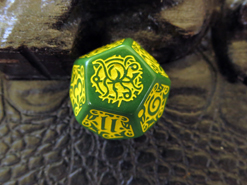 |
|
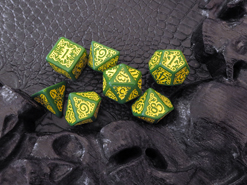 |
| | |
This set of dice contains the standard seven polyhedra, in which the largest number on all dice, except for the tetrahedron, is replaced by a esoteric symbol of madness. These symbols are associated with the occult pursuit of forbidden knowledge, beyond the comprehension of mortal men. Reckless pursuit of and exposure to unfathomable knowledge results in the debilitation of the mind. There is no systematic study indicating that the degree of mental impairment is proportional to any particular quality of the taboo information. On the contrary, it seems randomness, sometimes regarded as the whim of uncaring, alien gods, governs the extent of the derangement, as is often the case in matters relating to the discipline of madness. In the practice of divination, these stones are used to predict outcomes related to insanity, mental illness of all kinds as well as banned books and other subjects of censorship, sacred and profane.
These dice were manufactured by the Q-Workshop for the Pathfinder Roleplaying Game. These dice were specifically intended as part of the Strange Aeons Adventure Path, which was published in six monthly issues from August, 2016 to January, 2017.
December 9, 2018
| | |
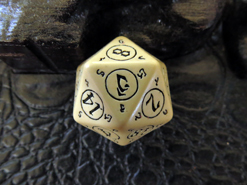 |
|
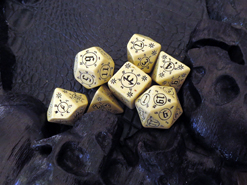 |
| | |
This set of dice contains the standard seven polyhedra, in which the largest number on all dice, except for the tetrahedron, is replaced by an ancient rune. These runes are associated with a lost race of human-like species, far advanced in the practice of medicine, psychology and other studies associated with the well-being of the body and mind. The ability to decipher the meaning of what few symbols are unearthed is limited as no document analogous to a Rosetta stone exists for these runes. As such, they would be studied with great care. It is supposed that the great ability to heal the body and mind can cause, if mishandled, commensurately great damage. In the practice of cleromancy, these stones are used to evaluate outcomes related to experimental medicine as well as in the rather unrelated activities of ciphering, code-breaking and other varieties of puzzle-solving.
These dice were manufactured by the Q-Workshop for the Pathfinder Roleplaying Game. These dice were specifically intended as part of the Rise of the Rune Lords Adventure Path, which was published in six monthly issues from August, 2007 to January, 2008.
December 9, 2018
This set of dice contains the standard seven polyhedra, in which the largest number on all dice, except for the tetrahedron, is replaced by the head of a fanged snake. These runes are associated with both human cults that worship snakes and supernatural beings, which combine the form of snakes and men. In the practice of cleromancy, these stones are used to predict any event relating to snakes and the effects of their venom.
These dice were manufactured by the Q-Workshop for the Pathfinder Roleplaying Game. These dice were specifically intended as part of the Serpent's Skull Adventure Path, which was published in six monthly issues from August, 2010 to January, 2011.
February 2, 2019
This set of dice contains the standard seven polyhedra, in which the largest number on all dice, except for the tetrahedron, is replaced by the head or weapons or another symbol associated with goblins. Goblins were originally mischievous spirits but later evolved into diminutive faerie folk of a decidedly malevolent and crude nature. Like dwarves, goblins are often associated with subterranean dwellings and mechanical ingenuity as well as competency with explosives. In the practice of cleromancy, these stones are used to predict any event relating to machines and incendiary devices, especially bombs and other weapons that combine aspects of both mechanization and munitions.
These dice were manufactured by the Q-Workshop for the Pathfinder Roleplaying Game. These dice are of a similar theme as various Pathfinder modules and comics.
March 16, 2019
In some traditions, the stones used in the practice of cleromancy are thought to be so connected to the divine world, that they are not to be polluted by coming in contact with mortal flesh. (Dice contaminated by the touch of a physical being are thought to provide erroneous horoscopes.) In such cases, some means of casting the stones other than tossing them by hand is employed. Typical examples, include cloth bags, stone bowls and wooden cups. In this example a leather cup is printed with the astral elder sign attributed to August Derleth on the front and a tentacle motif along rear seam. Typically, the insignia on the casting device corresponds to the otherworldly power addressed in the reading.
This dice cup was manufactured by the Q-Workshop.
March 16, 2018
This set of cleromancy dice are stored in containers designed after the fashion of books, within which one discovers not pages but stones. Unlike words written upon the pages of book, the knowledge hidden with a stone requires a different sort of erudition and is not so easily absorbed as the content of ordinary books. These books are often decorated with images and symbols indicating the nature of the information held within the stones.
All three sets of dice contain the standard seven polyhedra with an additional eleven six-sided dice. On all dice, the largest number is replaced by a particular symbol.
The symbol on the yellow and black dice is called the yellow sign, "thought to be a glyph from an alien language, likely that of dim Carcosa. Only those fully dedicated to the Yellow King wear it openly. Others who possess one, even unknowingly, become subject to the Yellow King's mental torment. Sometimes, just seeing the Yellow Sign can cause madness and calamity." In the practice of cleromancy, these dice are employed in the prognostication of any event involving Hastur, the King in Yellow. Because of reports of Hastur's form, the stones are also used in divination regarding cephalopods.
The symbol on the red and black dice is the Mark of the Necronomicon, This design has been found worked into the leather covers of the few existing copies of the Necromnomicon, the book, transcribed by the Mad Poet, Abdul Alhazred, containing knowledge not meant for mortal minds. In cleromancy, the stones are used (erroneously) in the search for forbidden knowledge. Their more accurate use is in divination regarding the preservation of knowledge or reclamation of forgotten information.
The symbol on the purple dice is the Sigil of the Dreamlands. This arcane design is synonymous with the mirror world of the Dreamlands. Humans often interface with this world through sleep. Passages, which allow for physical transport of the body to the dreamlands, exist but are rare. Their locations are well-guarded secrets and their entries are typically manned by men or beasts charged with preventing the entry of the waking. In the practice of cleromancy, these stones are used to interpret dreams.
These boxes were manufactured by Infinite Black. This is the second set of its kind. The first set is discussed in the original document titled, An Introductory Guide to Cleromancy.
February 2, 2019
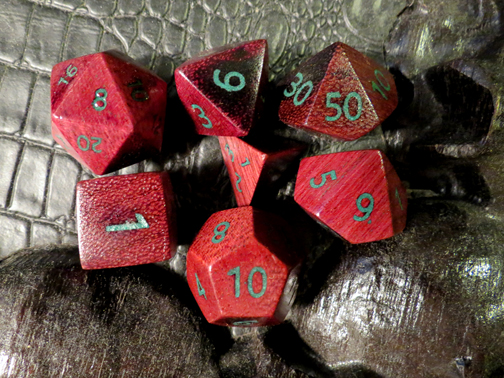
These stones are cut from purpleheart, the wood of (Peltogyne), a genus of flowering tree native to the American tropics. The dice were crafted by the artisans of Dog Might Games of Ann Arbor, Michigan. The engraved numbers are inlaid with crushed malachite. Malachite is a copper carbonate hydroxide mineral (Cu2CO3(OH)2) found underground. The combination of purple and green makes these stones well suited for divination on subjects concerning royalty and resurrection.
May 4, 2019
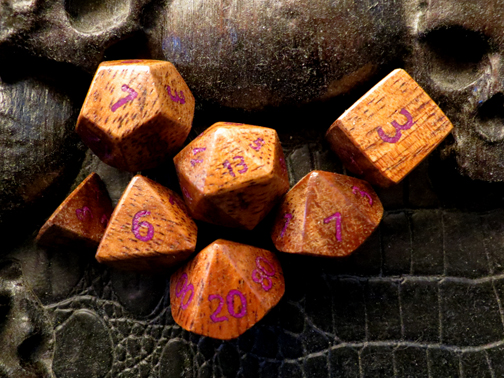
These stones are cut from bhilwara, the wood of (Albizia odoratissima), a genus of tree native to southeast Asia. The dice were crafted by the artisans of Dog Might Games of Ann Arbor, Michigan. The engraved numbers are inlaid with lapis lazuli, a deep-blue metamorphic rock, with a main component of the mineral lazulite, which has the chemical formula, (Na,Ca)8[(S,Cl,SO4,OH)2|(Al6Si6O24)]. Lapis lazuli is a semi-precious stone that has been prized since antiquity for its intense color. These dice have a peculiar ability for the numbers to disappear into the grain of the wood in anything but the clearest light. For this reason, they are thought to be especially potent stones for divination into particularly ambiguous subjects in which a previous attempt at prognostication has already failed.
February 22, 2020
This set of cleromancy dice are stored in containers designed after the fashion of books, within which one discovers not pages but stones. Unlike words written upon the pages of book, the knowledge hidden with a stone requires a different sort of erudition and is not so easily absorbed as the content of ordinary books. These books are often decorated with images and symbols indicating the nature of the information held within the stones.
All three sets of dice contain the standard seven polyhedra with an additional eleven six-sided dice. On all dice, the largest number is replaced by a particular symbol.
The symbol on the blue dice is called the Eye of Chaos, associated by some with Nyarlathotep, the Crawling Chaos. Nyarlathotep is reputed to have appeared through-out human history, though it is most associated with ancient Egypt. The stones are also used in divination regarding chaos, geometry and the after-life.
The symbol on the swirled blue and purple dice is the Seal of Yog-Sothoth. In the practice of cleromancy, these stones are used to predict outcomes regarding modifications of the body, including but not limited to conventional surgery.
The symbol on the purple dice is the Star of Azathoth, the Blind Idiot God. The most relevant use of these dice lies in divination regarding the cosmic physics, both spatial and temporal anomalies.
These boxes of stones were manufactured by Infinite Black. This is the third set of its kind. The first set is discussed in the original document titled, An Introductory Guide to Cleromancy and the second set appears at an earlier point in this addendum.
March 7, 2020
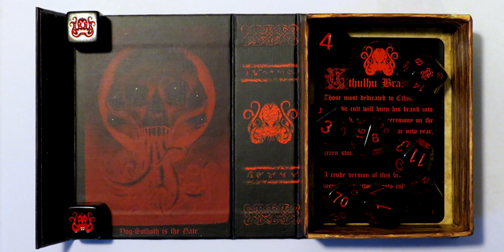
The symbol on these black dice is the head of Great Cthulhu, who, dead in his house at R'lyeh, waits dreaming. These stones are appropriate for matters of divination related to plagues, pandemics and viruses.
This box of stones was manufactured by Infinite Black.
March 14, 2020
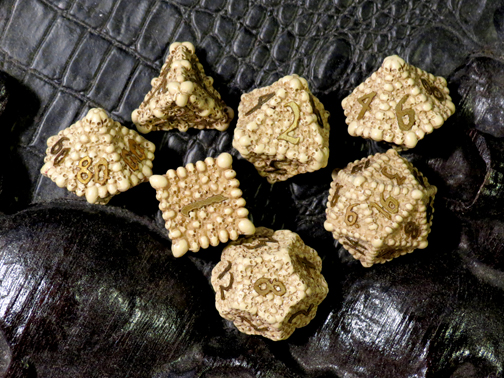
These stones are known as greater dice macabre. They are constructed from a polymer amalgamation of miniature skulls. On each face, a metal number has been affixed. The dice were crafted by the artisans of Q-Workshop of Poznań, Poland. Unsurprisingly, these stones are used in cleromantic inquiries into matters on the subject of death, including the time, location or manner of an impending death and the ultimate dispensation of a soul after death.
October 10, 2020
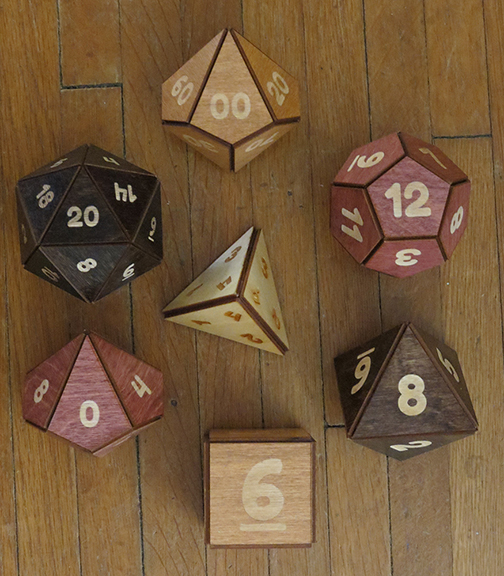
These dice are constructed of wood and are hollow. They are each several inches in dimension. The dice were manufactured by the craftsmen of Huntsbrook Inc. of Lexington, Kentucky. These dice are used in cleromantic investigations into issues in which there is conflict between the internal and external, particularly matters of subterfuge, deception and deceit.
November 13, 2021
This is the fourth set of three stones packaged in book-like boxes. All three sets of dice contain the standard seven polyhedra with additional six-sided dice and an extra twenty-sided die. On all dice, the largest number is replaced by a particular symbol.
The symbol on the purple blue dice is called the Crown of the Night Mother, patron of witches. The stones are also used in divination regarding covens, apostasy and ritual sacrifice.
The symbol on the blue dice is the Crest of Dagon, a fish god. The most relevant use of these dice lies in divination regarding sea travel, intercontinental trade and sea harvests.
The symbol on the swirled blue and purple dice is the Seer's Eye. In the practice of cleromancy, these stones are used to predict outcomes regarding the meta-science of prognostication.
These boxes of stones were manufactured by Infinite Black. This is the fourth set of its kind. The first set is discussed in the original document titled, An Introductory Guide to Cleromancy and the second and third sets appear at an earlier point in this addendum.
November 13, 2021
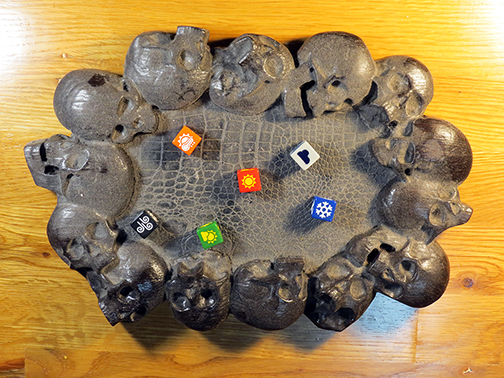
These plastic dice are used for predicting the weather. There are six versions, each corresponding to a particular environment: desert (red), tropics (orange), forest (green), arctic (blue), maritime (gray) and urban (black). The dice were crafted by the good folks at Steve Jackson Games of Austin Texas. For prognostications in which the weather is only one element of a larger inquiry, one of these dice can be added to other stones during a single casting.
June 2, 2024
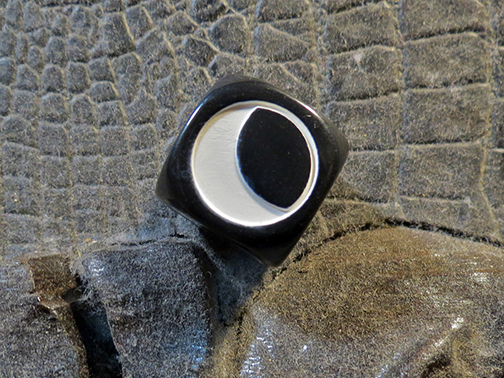
This plastic die is used for determining when a future event will come to pass, by identifying the phase of the moon at the time. This die was crafted by the good folks at Steve Jackson Games of Austin Texas. For prognostications in which the timing is only one element of a larger inquiry, this die can be added to other stones during a single casting.
June 2, 2024
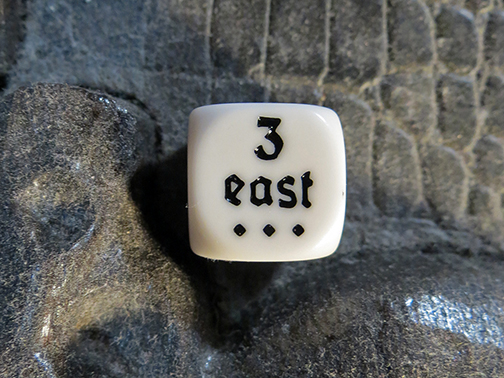
This six-sided plastic die has on each face one of the four cardinal directions of a compass as well as up and down. It is naturally used for determining direction. This die was crafted by the good folks at Steve Jackson Games of Austin Texas. For prognostications in which the direction is only one element of a larger inquiry, this die can be added to other stones during a single casting.
June 2, 2024
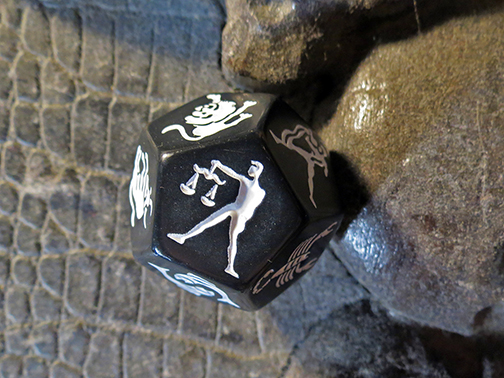
This twelve-sided plastic die has on each face one of the signs of the zodiac. It is used for determining the zodiac sign under which a person, especially an enemy, was born. Possessing knowledge of the individual's disposition provides advantage in dealing with or out-maneuvering them. This die was crafted by the good folks at Steve Jackson Games of Austin Texas. For prognostications in which the zodiac sign is only one element of a larger inquiry, this die can be added to other stones during a single casting.
June 2, 2024
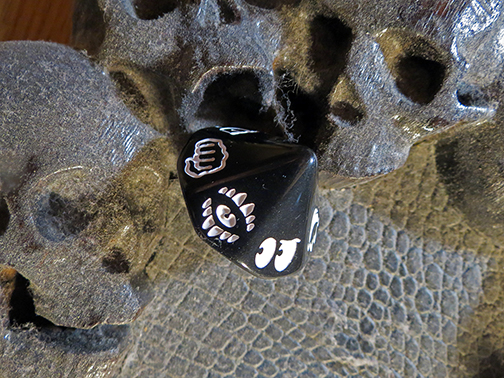
This fourteen-sided plastic die has on each face a symbol representing one of the seven deadly sins: envy, gluttony, greed, lust, pride, sloth and wrath. Each symbol is repeated twice. The die is used for determining the weakness of a specific person. As with the zodiac sign, described above, possessing knowledge of an individual's weakness grants an advantage in anticipating their actions. This die was crafted by the good folks at Steve Jackson Games of Austin Texas. For prognostications in which a deadly sin is only one element of a larger inquiry, this die can be added to other stones during a single casting.
June 2, 2024
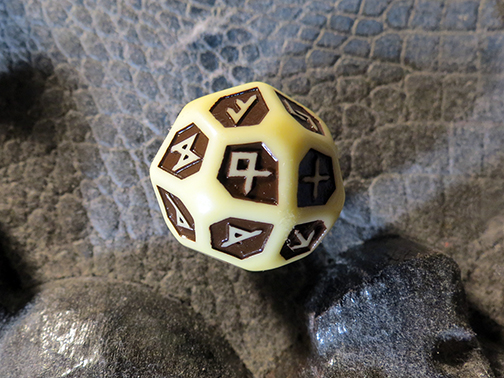
This twenty-four-sided plastic die has on each face a futhark rune. Each rune has a historical meaning, a deity with whom it is associated and a corresponding set of divinatory themes. When used as a means of cleromancy, this die finds general application, suggesting the broader context surrounding the subject of the query. This 24-sided polyhedron is called a "deltoidal icositetrahedron", a geometry found in the crystal structure of the garnet. This die was designed by Chuck Stover and was crafted by the good folks at Steve Jackson Games of Austin Texas. This version includes a manual for interpreting the meaning of each rune. The futhark die can be cast alone or can be added to other stones during a single casting.
June 2, 2024
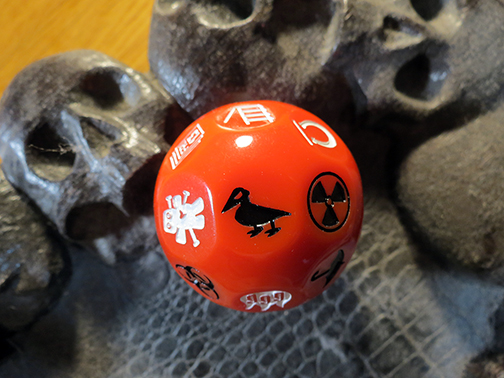
This twenty-six-sided plastic die has on each face one of thirteen symbols associated with bad luck. Each symbol is repeated twice, once in white and once in black. Some symbols refer to common bad luck tropes, e.g. a black cat, a broken mirror, a ladder or Friday the Thirteenth. Other symbols correspond to specific kinds of unpleasantness, including voodoo dolls, radiation and hellfire. To the best of our knowledge, this die has almost no function in the pursuit of cleromancy. This die was crafted by the good folks at Steve Jackson Games of Austin Texas.
June 2, 2024
In this set of seven plastic polyhedral dice, each die includes a spherical eye in its center, surrounded by a transparent liquid, which allows the eye to rotate as the die is rolled. In some venues, this technology is called "liquid core dice". Our modest attempts to determine who first created liquid core dice did not meet with success. Currently, such dice are widely available from retailers across the internet. Of note, many of these sets have a non-standard four-sided die. Rather than having the traditional tetrahedral shape, the four-sided die are an asymmetric octahedron with numbers one through four printed on only the larger half of the octahedron. In the practice of cleromancy, these stones are used to various ends depending upon their color, but all involve themes of vision, blindness, confinement, water and flame. The blue die have a special affinity for prognostications involving drowning, while the red die prove most accurate when employed in readings where conflagration or immolation are at risk. The green die are attuned to investigations into the fate of those lost in the wildnerness and those in danger of amputation. The purple die are used to commune with those who died of a drug overdose.
June 19 & 22, 2024
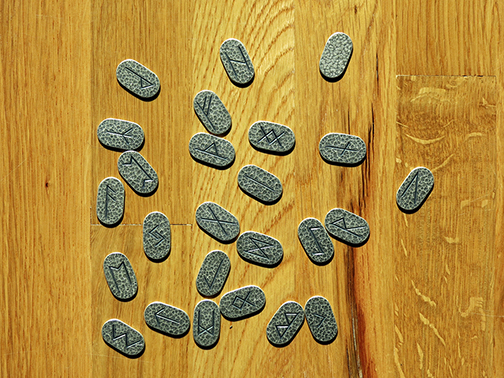
Each piece of this set of twenty-four silver tokens is struck with an elder futhark rune. Each rune has a historical meaning, a deity with whom it is associated and a corresponding set of divinatory themes. This set of coins was minted by the good folks at Shire Post Mint of West Fork, Arkansas. This set includes a manual for interpreting the meaning of each rune. The futhark coins are appropriate for divination into disturbances by evil spirits and to seek psychic protection from malign actors, corporeal and otherwise.
December 26, 2024
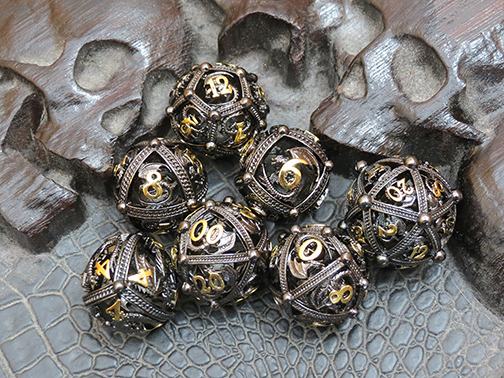
These stones take the idea of the standard seven polyhedral die and realize them as hollow metal orbs inscribed with dragons. This set of die was created by the good folks at Soar Forge. They make a tingling sound when they are rolled as a group. These orbs are appropriate for divination into any matter that involves objects with spherical geometry, including competitions in the realm of billiards, marbles, bowling and other sundry contests with spherical balls.
January 12, 2025
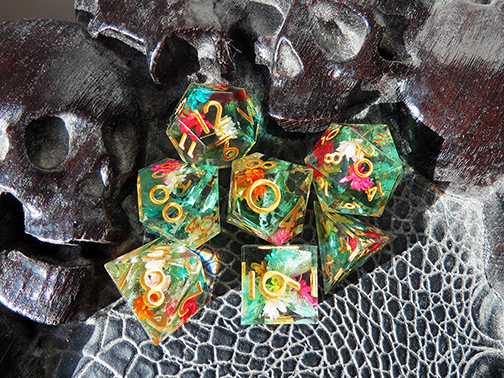
These stones adopt the standard seven polyhedral die. Trapped like insects in amber, flowers are captured within each translucent dice. This set of die was created by the good folks at LDICEK. These stones are appropriate for divination into outcomes of gardening and other agricultural endeavors.
January 12, 2025
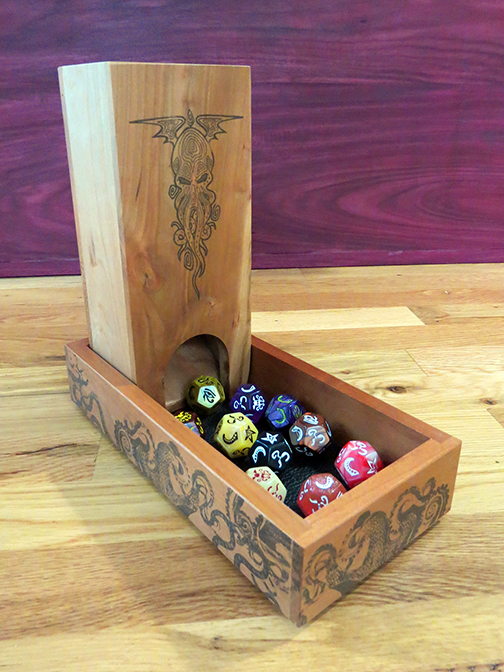
In order to minimize bias in the casting of stones, incidental or otherwise, so-called dice towers can be used in the casting. This particular tower was crafted by Dragon Armor Games of Knoxville, Tennessee. Its use is appropriate for divination into issues of ambiguous paternity as well as epistemological matters, including that gained through occult channels.
June 15, 2025
|
|
|
|

